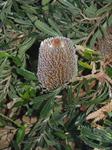PROPAGATING BANKSIAS

Banksias may be propagated by seed, cuttings, tissue culture or grafting.
Seed propagation is the easiest and the way most nurseries have (traditionally) grown Banksias. Seed is encased in a hard woody fruit that rarely opens to release seed except in extreme heat, such as a fire. This characteristic protects seeds from being eaten by insects or other animals until plant regeneration is needed. After a fire, seed tends to be released dispersed and will germinate in large quantities. Many though not all species have lignotubers that will sprout foliage and regenerate a damaged plant after a fire.
Seed Propagation
Collect seed cones when seed is ripe, but before seed drops (for some varieties this is easy, for others, there is a relatively short period when seed can be collected).
They are best left in a pot of seed raising mix in the open or an unheated greenhouse (do not place in a heated greenhouse).
Cutting Propagation
Some Banksia species have been grown successfully by cuttings when treated with root promoting hormones. Other factors influencing successful rooting include temperature (a root temperature of around 25 degrees Celsius seems generally appropriate), ventilation (do not crowd pots in a propagating bed, and do not crowd cuttings in a pot), a clean disease free environment, and minimal humidity (capillary watering may be worth experimenting with). Rooting generally takes up to 6 months to occur.
Germination may commonly take between 3 weeks to 3 months. This period of time may be reduced for some species by treating seed with smoke; smoke treatment also encourages more consistent germination, a better germination rate and sturdier seedlings.
Tissue Culture
Tissue culture has been used successfully to propagate some
Banksias, however there has to date always been difficulty in transferring plants from the laboratory into soil.
The technique may have potential, but is not yet used commercially, to our knowledge.
Grafting
Grafting involves joining parts of plants in a way that they will grow together and remain united as one plant. The part of the graft combination which becomes the upper part of the new plant, is called the scion. The part which becomes the bottom part is called the rootstock or stock. All methods of joining two plants together this way are forms of grafting however, when the scion is only a small piece of bark containing a single bud, the technique is called “budding”.
Read more about Banksias with our
Banksia ebook.